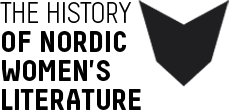Súsanna Helena Patursson one of a number of women writers in the national movement. She wrote the first Faroese theatre play, Veðurføst (Layover Because of Bad Weather), which was performed in 1889. She encouraged women to participate in the public discussion forum, to get an education, and she instructed them as to how house and home should be organised. She edited and published the first Faroese women’s magazine, Oyggjarnar (1905-08; The Islands), making housekeeping, interior design, and cooking recipes a national and political issue.Among Paturssons female successors may be counted women such as Billa Hansen, Andrea Reinert, and Maria Mikkelsen. While these women travelled out into the world in order to learn, get ideas and, not least, experience, Johanna Maria Skylv Hansen’s writing took her back to the old rural community.
Tag: Love
Hulda Garborg wrote a lot, alternating between articles for journals and novels, but she concentrated particularly on various theatre genres. Much of her work was written in connection with the nynorsk movement, which in the 1880s and 1890s received increased impetus, with Hulda Garborg as one of its prominent figures. From 1910 until 1912, Hulda Garborg was the leader of a touring theatre company, Det Norske Spellaget, which travelled along the Norwegian coast. The success of the tour gave Hulda Garborg the courage to set up a permanent stage in Christiania for nynorsk drama.The very next year saw Det Norske Teatret (The Norwegian Theatre) become a reality. She sat on the board for many years, and she also occasionally directed shows, but what she really wanted to be was a writer. She uses material from Norwegian national literature and the Norse heritage, but she was also inspired by mysticism and Eastern philosophy of religion.
After a marriage to celebrated Danish writer Jeppe Aakjær that did not last, Marie Bregendahl coped with life as a single mother by keeping house for her brother who owned a dairy in the Nørrebro district of Copenhagen. Nor was she able to go back; exodus and city were forever part of her make-up. The tension between the rural culture of her childhood and the anonymised city life, in which the individual had to create an identity for her- or himself, became the empirical sounding board for her entire body of works.In this, she carried on the Modern Breakthrough’s naturalistic portrayal of reality, but in her very own distinctive way in which the traditional narrative forms and the modern woman’s chaos of conflicting experience both found a voice.
How come a daughter of the liberal, albeit conservative ultra-respectable professor and hofmedicus (court physician) Carl Henrik Horn Nebelong was fooling about like a bohemian in Copenhagen cafés with her female friends and aspiring writers, and also writing audacious novels about the straitened circumstances of women’s desire in petit-bourgeois and double-standards patriarchal Denmark?
Agnes Henningsen’s world is like a geographical and ideological map. Denmark is mirrored in Europe, Danish province in Copenhagen city, ingrained middle-class in radical bohemian; and the widely different attitudes of the times converge – social, political, religious – assembled in a hot-spot: that of love and independence, which in Agnes Henningsen’s writings are the absolute premise of female desire.She takes issue with the sanctimonious institutionalisation of love – which causes hypocrisy, martyrdom, hysteria, and furtiveness, while continually threatening any natural development of the female sexual life.
The bohemian authors aspired to a sense of life and art that could break open the boundaries both for oppressive bourgeois respectability and fatuous modernity. This applied to the women of the bohemia as well. But for them, freedom and liberation were not synonymous with the feminists’ demand for the right to vote, but a question of self-realisation in love and art.If the male figure-heads of the bohemian milieu caused scandal, the women did too – and to no less a degree. As bohemians they offended against every norm of what constituted a decent life for a woman as wife, as mother, as the heart and mind of the home. At the same time, it was for this femininity that they were fetishised in the bohemian milieu.
New Faroese Women’s Literature
The few Icelandic women writers to appear around the turn of the twentieth century travel from the countryside to Reykjavík. But it is not contemporary Iceland that frames, in their literary works, their depiction of Icelandic women’s struggles of the modern age.They choose the past as a time frame, the journey back to the patriarchal farming community from which the contemporary identity conflicts and attempted exoduses spring. From this perspective, they thematise the conflicts between duty and freedom and the ambivalence concerning women’s new liberation.
Gender and Class in Icelandic Women’s Literature of the 1970s
The start of the 1960s saw the publication of the first poetry collection by Vilborg Dagbjartsdóttir who, as a modernist and a multifaceted cultural figure, has inspired both a younger generation of Icelandic female poets and poets of her own generation.Poets such as Þóra Jónsdóttir, who made her debut in 1973, and Þuríður Guðmundsdóttir, who published her first book in 1969, were, like Vilborg Dagbjartsdóttir, born and brought up in the countryside, and later settled in Reykjavík, and they are, to some extent, preoccupied with the same poetic subjects. They express themselves in precisely chiselled, minimalist poems that demand the reader’s full attention.

